
Owner’s Manual
1833, 1834, 1835, 1837
PC Programmable Telephone Entry and Access Control Systems
DoorKing, Inc.
120 Glasgow Avenue
Inglewood, California 90301
U.S.A.
Phone: 310-645-0023
Fax: 310-641-1586
www.doorking.com
P/N 1835-065 REV T, 7/12
Copyright 2003 DoorKing, Inc. All rights reserved.

Page 2 1835-065-T-7-12

Use this manual with the following models only.
1833, 1835 and 1837 Telephone Entry Systems with circuit board REV U or Higher and 1834
Telephone Entry Systems with circuit board REV T or higher.
DoorKing, Inc. reserves the right to make changes in the products described in this manual
without notice and without obligation of DoorKing, Inc. to notify any persons of any such revisions
or changes. Additionally, DoorKing, Inc. makes no representations or warranties with respect to
this manual. This manual is copyrighted, all rights reserved. No portion of this manual may be
copied, reproduced, translated, or reduced to any electronic medium without prior written consent
from DoorKing, Inc.
1835-065-T-7-12 Page 3

TABLE OF CONTENTS
Prefa
ce
Important Notices......................................................................................................................................................7
General Information..................................................................................................................................................8
Features ..................................................................................................................................................................9
Section 1 – Installation
1.1 General Installation Information................................................................................................................11
1.2 Surface Mount Units.................................................................................................................................12
1.3 Surface Mount Units with Recess Box .....................................................................................................13
1.4 Flush Mount Units.....................................................................................................................................14
1.5 Flush Mount Rough-in Box.......................................................................................................................15
1.6 Flush Mount Trim Ring.............................................................................................................................16
1.7 Flush Mount Surface Mounting Kit ...........................................................................................................17
1.8 Wall Mount Units ......................................................................................................................................18
1.9 Memory Chip Installation..........................................................................................................................19
1.10 Postal Lock Installation.............................................................................................................................20
Section 2 – Wiring
General Information..................................................................................................................................................21
2.1 Wiring Guidelines .....................................................................................................................................22
Terminal Descriptions...............................................................................................................................................23
2.3 Wiring Detail
2.3.1 Controller Only .........................................................................................................................24
2.3.2 Controller and Expansion Boards 1-8 ......................................................................................25
2.3.3 Controller and Expansion Boards 1-16 ....................................................................................26
2.4 RS 232 Cable Connections......................................................................................................................27
Section 3 – Programming
3.1 General Programming Information
3.1.1 Programming with a PC ...........................................................................................................29
3.1.2 Programming from the Keypad ................................................................................................30
3.1.3 System Memory .......................................................................................................................30
3.2 Programming with a PC
3.2.1 Master Code.............................................................................................................................31
3.2.2 Programming the Number of Area Codes Allowed ..................................................................31
3.2.3 Programming for Call Up Operation.........................................................................................32
3.2.4 Programming Resident Elevator Button Relay Time................................................................32
3.2.5 Open Tone On or Off................................................................................................................32
3.2.6 RS-232 Speed Setting..............................................................................................................32
3.2.7 Switch Input Function...............................................................................................................33
3.2.8 Elevator Control Function.........................................................................................................33
3.2.9 Fiber Optic / POTS Telephone Line Setting.............................................................................33
3.3 General Programming
3.3.1 Relay Strike Time.....................................................................................................................34
3.3.2 Talk Time..................................................................................................................................34
3.3.3 Tone Open Numbers................................................................................................................35
3.3.4 Switch Input..............................................................................................................................35
3.3.5 Touch-tone / Rotary-dial...........................................................................................................36
3.3.6 Single or Multiple Systems.......................................................................................................36
3.3.7 Clock Programming..................................................................................................................36
Page 4 1835-065-T-7-12

3.4
Programming Letters, Numbers and Messages
3.4.1 Programming Letters and Numbers.........................................................................................37
3.4.2 Programming the User Message – 1834, 1835 .......................................................................38
3.4.3 Programming the Instruction Message – 1834, 1835 ..............................................................39
3.4.4 Programming the User Message – 1837 .................................................................................40
3.4.5 Programming the Instruction Message – 1837 ........................................................................41
3.5 Programming Phone Numbers and Names .............................................................................................42
3.5.1 Programming the Directory Code Length.................................................................................43
3.5.2 Programming 7-digit Phone Numbers......................................................................................43
3.5.3 Programming Area Codes........................................................................................................44
3.5.4 Programming Phone Numbers with Area Codes .....................................................................44
3.5.5 Programming Names ...............................................................................................................45
3.5.6 Deleting Individual Phone Numbers.........................................................................................45
3.5.7 Delete Names ..........................................................................................................................45
3.5.8 Delete Area Codes...................................................................................................................46
3.5.9 Display Phone Numbers ..........................................................................................................46
3.5.10 Programming PBX Line Access Code .....................................................................................46
3.5.11 Touch-tone Dialing Pause........................................................................................................47
3.6 Device Codes
3.6.1 Programming Device Codes ....................................................................................................48
3.6.2 Deleting Device Codes.............................................................................................................48
3.6.3 Enabling Facility Codes............................................................................................................48
3.6.4 Programming Facility Codes....................................................................................................48
3.7 Four-digit Entry Codes
3.7.1 Programming Four-digit Entry Codes.......................................................................................49
3.7.2 Delete Four-digit Entry Codes..................................................................................................49
3.7.3 Entry Code Ranges..................................................................................................................49
3.8 Anti-Pass Back
3.8.1 Programming Anti-Pass Back Mode........................................................................................50
3.8.2 Re-Sync All Devices.................................................................................................................50
3.8.3 Re-Sync Individual Devices .....................................................................................................50
3.8.4 Reset Facility Counter..............................................................................................................50
Section 4 – Adjustments
Circuit Board Adjustments Location .........................................................................................................................51
Circuit Board Adjustment Descriptions and Instructions...........................................................................................52
Section 5 – Operating Instructions
5.1 Guest Instructions ....................................................................................................................................55
5.2 Resident Instructions
5.2.1 Responding to a Guest Call .....................................................................................................56
5.2.2 Using an Entry Code................................................................................................................56
5.3 System Administrator
5.3.1 Opening from a Remote Location ............................................................................................57
5.3.2 Tracker Board Override Hold Open Command........................................................................57
5.3.3 Relay Check.............................................................................................................................58
5.3.4 Time and Date Check ..............................................................................................................58
5.4 Miscellaneous Operating Instructions
5.4.1 Talk Time..................................................................................................................................59
5.4.2 Line Sharing.............................................................................................................................59
5.4.3 Connection to a PBX................................................................................................................59
5.4.4 10-digit Dialing .........................................................................................................................59
1835-065-T-7-12 Page 5

Section 6 – Maintenance and Trouble Shooting
6.1 Trouble Shooting......................................................................................................................................61
6.1.1 RS-232 Test.............................................................................................................................63
6.1.2 Modem Output Level................................................................................................................63
6.1.3 Wiegand Test...........................................................................................................................64
6.1.4 Elevator Board Hardware Test.................................................................................................64
6.1.5 Elevator Board Floor Hardware Test........................................................................................65
6.1.6 Automatic Hang-up Options.....................................................................................................65
6.2 Accessories..............................................................................................................................................66
6.3 Log Tables................................................................................................................................................67
Page 6 1835-065-T-7-12

IMPORTANT NOTICE
FCC - UNITED STATES
This equipment has been tested and found to comply with the limits for a class A digital device,
pursuant to Part 15 of the FCC Rules and Regulations. These limits are designed to provide
reasonable protection against harmful interference when the equipment is operated in a commercial
environment. This equipment generates, uses, and can radiate radio frequency energy and, if not
installed and used in accordance with the instruction manual, may cause harmful interference to radio
communications. Operation of this equipment in a residential area is likely to cause harmful
interference in which case the user will be required to correct the interference at his own expense.
FCC Registration Number: DUF6VT-12874-OT-T
DOC - CANADA
The Canadian Department of Communications label identifies certified equipment. This certification
means that the equipment meets certain telecommunications network protective, operational, and
safety requirements. The Department does not guarantee the equipment will operate to the users
satisfaction.
Before installing this equipment, users should ensure that it is permissible to be connected to the
facilities of the local telecommunications company. The equipment must also be installed using an
acceptable means of connection. The customer should be aware that compliance with the above
conditions may not prevent degradation of service in some situations.
Repairs to certified equipment should be made by an authorized Canadian maintenance facility
designated by the supplier. Any repairs or alterations made by the user to this equipment, or
equipment malfunctions, may give the telecommunications company cause to request the user to
disconnect the equipment.
Users should ensure, for their own protection, that the electrical ground connections of the power
utility, telephone lines, and internal metallic water pipe system, if present, are connected together.
This precaution may be particularly important in rural areas.
CAUTION: Users should not attempt to make such connections themselves, but should contact the
appropriate electric inspection authority, or electrician, as appropriate.
DOC Registration Number: 1736 4528 A
Notice:
The Load Number (LN) assigned to each terminal device denotes the percentage of the total load to
be connected to a telephone loop which is used by the device, to prevent overloading. The
termination on a loop may consist of any combination of devices subject only to the requirement that
the sum of the load numbers of all the devices does not exceed 100.
Notice:
DoorKing does not provide a power transformer on units sold outside of the United States. Use only
transformers that are listed by a recognized testing laboratory to power the telephone entry system.
An Inherently Protected Transformer must be used to power this device. 1833, 1834 and 1835
systems require a 16.5-volt, 20 VA transformer. The model 1837 requires a 16.5-volt, 40 VA
transformer.
Listing:
This product has been tested to and found to be in compliance with the U.L 294 Safety Standard by
Intertek Testing Services NA Inc. (a Nationally Recognized Testing Laboratory) and is ETL listed.
1835-065-T-7-12 Page 7

GENERAL INFORMATION
Prior to beginning the installation of the telephone entry system, we suggest that you become
familiar with the instructions, illustrations, and wiring guidelines in this manual. This will help
insure that you installation is performed in an efficient and professional manner.
Telcom Access Standards. It is not permissible for customers to use the telcom network
lead-in cable to provide the intercom function between the gate and the house.
New Zealand Customers: All door and gate entry systems wiring must comply with PTC106:
March 2008, Section 9.
The proper installation of the telephone entry panel is an extremely important and integral
part of the overall access control system. Check all local building ordinances and building
codes prior to installing this system. Be sure your installation is in compliance with local
codes.
When used to control a door or pedestrian gate, try to locate the telephone entry system as
near as possible to the entry point. The unit should be mounted on a rigid wall to prevent
excessive shock and vibration from closing doors or gates. Continuous vibration and shock
from slamming doors or spring-loaded pedestrian gates will damage the circuit board. Under
no circumstances should the unit be mounted directly to a moving door or gate.
ADA mounting requirements for door control (Ref: ICC/ANSI A117.1-2009).
1. Unobstructed Forward Reach
. Where a clear floor or ground space allows only a
forward approach to an object and is unobstructed, mounting height shall be a
minimum of 15 inches (381 mm), and a maximum of 48 inches (1.22 m), above the
floor or ground to the operable controls.
2. Obstructed High Forward Reach
. If the high forward reach is over an obstruction
greater than 20 inches, but less than 25 inches, mounting height shall be a maximum
of 44 inches (1.12 m) above the floor or ground to the operable controls.
3. Unobstructed Side Reach
. Where a clear floor or ground space allows a parallel
approach to an object and the side reach is unobstructed, and the edge of the clear
floor space is 10 inches (255 mm) maximum from the object, mounting height shall
be a minimum of 15 inches (380 mm), and a maximum of 48 inches (1.22 m), above
the floor or ground to the operable controls.
4. Obstructed High Side Reach
. If the side reach is over an obstruction greater than 10
inches, but less than 24 inches, mounting height shall be a maximum of 46 inches
(1.17 m) above the floor or ground to the operable controls.
WARNING: When used to control a vehicular gate with an automatic gate operator, the
telephone entry system must be mounted a minimum of ten (10) feet away from the
gate and gate operator, or in such a way that a person cannot operate the entry system
and/or touch the gate or gate operator at the same time.
Be sure that the system is installed so that it is not directly in the traffic lane. Goose neck
mounting post and kiosks work well for these type systems. When planning where to locate
the system, take into consideration traffic lane layouts, turn around lanes for rejected access,
conduit runs, power availability, etc.
Environmental factors must also be taken into account. Surface mount units are designed for
direct outdoor installation; however it is preferable to protect them from direct exposure to
driven rain or snow whenever possible. Flush mount and wall mount units must be protected
from direct exposure to the elements. Be sure that ample lighting is provided so that guest
can read both the directory and the operating instructions at night.
This telephone entry system contains a number of static sensitive components that can be
damaged or destroyed by static discharges during installation or use. Discharge any static
prior to removing the circuit board from the lobby panel by touching a proper ground device.
Page 8 1835-065-T-7-12

FEATURES
Can provide service for up to 3000 residents.
Can store up to 8000 card, transmitter or digital PIN codes (not applicable to 1834).
System can be programmed with a PC by modem, RS-232, RS-422 (requires 1508-055
adapters), a LAN connection (requires 1830-175 TCP/IP kit) or via the internet using the
Internet Modem Server (use of the IM Server is fee based. Visit
http://www.doorking.com/IMServer
for more information).
ONE TOUCH CALLING provides the easiest to use system on the market (does not apply to
1833).
System keypad will emit DTMF tones after a call is answered allowing the system to be used
with auto-attendants, answering machines, etc.
Directory codes can be set from 1 to 4 digits in length and can be randomly assigned.
Transaction buffer stores the last 8000 events and has its own backup power source to retain
memory during power outages.
View LIVE transactions.
31-security levels total (security level 00 always denies entry, security level 01 always admits
entry), with 29 programmable security levels, each with four time zones allows you to control
and restrict user access as needed (not applicable to 1834).
Programmable holiday schedule (not applicable to 1834).
Facility codes can be enabled or disabled. Store up to 10 different facility codes (not
applicable to 1834).
True Anti-Pass Back feature.
Up to 255 programmable area codes (Rev E and higher boards only) allow the system to be
used in areas requiring 10 and 11-digit dialing.
Three internal relays allow the system to control a main entry point plus two additional entry
points (1834 system has only 2 relays).
System can be expanded to control up to 16 entry points in addition to the main entry point.
Tracker expansion boards are required (one for each additional entry point) and are not
included with the system. Tracker boards also provide output for door ajar and forced entry
alarms (not applicable to 1834).
Optional elevator control board(s) can control up to four elevators with each elevator serving
up to 64 floors (not applicable to 1834).
System will interface with selected models of DKS DoorKing vehicular gate operators to
provide gate operator information and data (requires a Tracker board for each gate operator
that is to send data to the system). Not applicable to 1834.
Available in surface, flush or wall mount styles (1833 available in surface or flush mount
only).
1835-065-T-7-12 Page 9

Page 10 1835-065-T-7-12

SECTION 1 - INSTALLATION
Order your telephone line at least two weeks prior to the planned installation date. This will assure
that a phone line is available when the unit is installed. The telephone company will require the
following information from you:
Type: Touch Tone, Loop Start
Ringer Equivalence: 0.0 A
Jack Type: RJ11C
FCC Registration (US): DUF6VT-12874-OT-T
DOC (Canada): 1736 4528 A
Electrical Listing: Complies with U.L. 294 - ETL Listed
CALLER ID: You may want to consider ordering caller ID blocking from the telephone company for
the entry system phone line. Without caller ID blocking, tenants with the proper phone equipment will
be able to identify the telephone number that the entry system is installed on. This may or may not
be desirable.
1.1 General Installation Information
1. Open the cabinet of the telephone entry system and disconnect the keypad ribbon cable
from the main circuit board.
2. Remove the 6-32 x 1/2 round head screws from the upper corners of the circuit board.
3. Remove the circuit board by gently pulling it out of the main terminal edge connector.
CAUTION - the circuit board contains static sensitive components. Discharge any static
electricity from your hands by touching a proper ground device before removing the
circuit board. Place the circuit board where it will not be damaged.
4. Mount the cabinet using the mounting holes provided in the corners. Be sure that
mounting screws do not protrude into the cabinet where they could cause a short on the
back of the circuit board. Make any necessary conduit connections using the conduit
knockouts provided on the back and/or bottom of the cabinet. DO NOT make any other
conduit holes in the cabinet.
5. Route wiring into the cabinet. Do not apply any power at this time.
6. Clean out the cabinet. Be sure that all dirt, metal and/or wood debris is removed from the
cabinet and that the terminal strip edge connector is clean and free of any loose particles.
7. Re-install the circuit board into the cabinet by gently pushing the circuit board terminals
into the edge connector. CAUTION - the circuit board contains static sensitive
components. Discharge any static electricity from your hands by touching a proper
ground device before removing the circuit board.
8. Secure the circuit board to the cabinet using the screws removed in step 2.
9. Plug the keypad ribbon cable into the circuit board. The cable points down.
1835-065-T-7-12 Page 11

1.2 Surface Mount Units
Surface mount units can be mounted directly to a wall or pilaster, or can be post mounted using a
DoorKing Architectural Style mounting post (p/n 1200-037 and 1200-038). Be sure the unit is
mounted securely and is not subject to vibration from closing doors or gates.
DOORKING, INC., INGLEWOOD, CA 90301
Date: Dwg. No.
Surface Mount Case and Mounting Hole
Dimensions
Rev.
Title:
10/05
B
M1835-065-6
2.625
1.625
.875 DIA
.25 DIA
13.0
10.875
11.25
5.625
2.625
1.125
.875 DIA
.875
4.75
Standard Surface Mount Housing Case and Mounting
Hole Dimensions
1
3.25
9.0
10.125
Page 12 1835-065-T-7-12

1.3 Surface Mount Units with Recess Box
Surface mount units can be semi-flush mounted into a wall or pilaster by using the optional recess-
mounting box (p/n 1803-150). Be sure the unit is mounted securely and is not subject to vibration
from closing doors or gates.
2.687 6.0
1.125.437 2.063
3.5
11.375
3.5 2.187
.25 DIA
10.125
13.375
2.187
3.375
10-24 x 1.25 STUD (4 PL)
1.625
15.25
8.5
10.875
1.375 DIA
.25 DIA
2.187
6.0 3.687
.437
3.625
.25 DIA
2.25
4.875
8.375
11.0
13.25
Standard Surface Mount Recess Mounting Box
Surface Mount Entry System
Recess Mount Box
DOORKING, INC., INGLEWOOD, CA 90301
Date: Dwg. No.
Surface Mount Recess Mounting Box
Rev.
Title:
10/05
B
M1800-065-2
9.0
9.0
1835-065-T-7-12 Page 13

1.4 Flush Mount Units
Flush mount units are installed into a wall with flush mount kits 1814-165 (stainless) or 1814-166
(gold). Flush mount kits are not included with the entry system. Flush mount units are not designed
for direct exposure to the weather. Be sure the unit is mounted securely and is not subject to
vibration from closing doors or gates.
3.0
13.0
2.5
1.625
.875 DIA
1.125
1.125
12.0
.875
.50
2.625 2.625
5.625
.875 DIA
11.25
13.25
10.875
DOORKING, INC., INGLEWOOD, CA 90301
Date: Dwg. No.
Flush Mount Units
Rev.
Title:
10/05
B
M1800-065-3
Flush Mount Units
9.0
.25 DIA
10.125
Page 14 1835-065-T-7-12

1.5 Flush Mount Rough-in Box
The flush mount installation kit has two parts; the rough-in box and the trim ring. The rough-in box is
installed first.
1.91410.886
3.400
1.125 DIA (3 PL)
3.450
1.300
14.600
1.740
1.740
1.7004.700
.275 DIA (3 PL)
Flush Mount Rough-in Box
(Flush mount rough-in box is included with the 1814-165 and 1814-166 flush mount kits)
DOORKING, INC., INGLEWOOD, CA 90301
Date: Dwg. No.
Flush Mount Rough-in Box
Rev.
Title:
4/11
D
M1800-065-4
10.120
12.800
10-32 x .75 Stud (4 PL)
1.800
1.685
1.500
3.0003.000
1.800
4.700
6.000 3.400
1.125 DIA (2 PL)
3.0003.000 3.0003.000
.275 DIA (5 PL)
1835-065-T-7-12 Page 15

1.6 Flush Mount Trim Ring
Flush mount units can be mounted by using the 1814-165 (stainless) or 1814-166 (gold) mounting kit.
Flush mounting kits are not included with the unit. Flush mount units are not designed for direct
exposure to the weather. Be sure the unit is mounted securely and is not subject to vibration from
closing doors or gates.
1.575
3.100
12.200
1.250 DIA (3 PL)
3.450
13.555
14.700
1.250 DIA (3 PL)
10.886
16.055
DOORKING, INC., INGLEWOOD, CA 90301
Date: Dwg. No.
Flush Mount Trim Ring
Rev.
Title:
4/11
D
M1800-065-5
Flush Mount Trim Ring (P/N 1814-165 and 1814-166)
Rough-in Box
Trim Ring
Entry System
10.120
.286 DIA (4 PL)
3.000 3.000
1.250
4.5053.100
1.325
Page 16 1835-065-T-7-12

1.7 Flush Mount Surface Mounting Kit
Flush mount units can be surface mounted by using the optional 1814-152 surface mount trim ring.
Flush mount units are not designed for direct exposure to the weather. Be sure that the unit is
securely mounted and is not subject to vibration from closing doors or gates.
2.625
13.5
1.125 DIA 1.125 SQ
.375
.875
1.125
9.0
7.5
6.0
3.0
.375
1.0
12.0
DOORKING, INC., INGLEWOOD, CA 90301
Date: Dwg. No.
Surface Mount Kit for Flush Style Units
Rev.
Title:
3/03
A
M1800-065-6
Surface Mount Kit for Flush Style Units
Flush Unit
Flush Mount Ring
1835-065-T-7-12 Page 17

1.8 Wall Mount Units
Wall mount units are designed to be mounted directly onto a wall without the need of cutting a large
hole as is necessary with flush mount units. Be sure the unit is mounted securely and is not subject
to vibration from closing doors or gates.
2.0
3.625 3.0 3.0
.875 DIA
.25 DIA
13.25
10.875
15.0
3.5
DOORKING, INC., INGLEWOOD, CA 90301
Date: Dwg. No.
Wall Mount Case and Mounting Hole Dimensions
Rev.
Title:
10/05
B
M1800-065-7
Wall Mount Housing Case and Mounting Hole
Dimensions
9.0
10.125
Page 18 1835-065-T-7-12

1.9 Memory Chip Installation
The telephone entry system is shipped with the memory chips already installed in the unit. However,
if you need to change the memory chips (to match an older unit, for example), follow the instructions
below.
CAUTION!! Do not install the memory chips with power to the telephone entry system turned
on. Attempting to install the memory chips with power on will irrevocably damage the chips.
Memory chips are a static sensitive component. Discharge any static electricity from your
hands by touching a proper ground device before removing the control board. Handle the
memory chips with care.
1. The large memory chip socket is colored black and is located in the center of the circuit
board. Be sure that the handle is in the un-locked position (pointing up).
2. Carefully insert the memory chip into the socket. The small half circular indentation on
the chip must be at the top. CAUTION: Installing the memory chip upside down will
cause permanent damage to the chip. Be sure that the memory chip is seated correctly
in the socket, then move the lever on the chip socket to the locked position (down).
3. Install the small memory chip in the socket located at the bottom of the circuit board. The
small circular indentation on the chip must be at the top. CAUTION: Installing the
memory chip upside down will cause permanent damage to the chip. Be sure that the
memory chip is seated correctly in the socket.
1830 Series Circuit Boards Memory Chip Location
1
1
Dimple on chip must be at top!
1
DOORKING, INC., INGLEWOOD, CA 90301
Date: Dwg. No.
1830 Series Memory Chip Location
Rev.
Title:
3/03
A
M1835-065-1
1835-065-T-7-12 Page 19

1.10 Postal Lock Installation
At some locations, such as gated communities, it will be necessary to provide access to the mail
carrier so that they can deliver the mail. Mail carrier access will be provided by the installation of an
Arrow Postal Lock. This is the same lock that the Post Office uses for gang mailboxes. These locks
are not available to the public. The installer or the building owner/manager will have to call the Post
Office and arrange for the installation of this lock into the telephone entry system. All DoorKing
commercial telephone entry systems are designed to accept installation of the postal lock.
Prior to installation of the postal lock, be sure power to the telephone entry system is turned off.
1. Remove the hole plug on the faceplate of the telephone entry system.
2. Cut the wire tie wrapped around the micro switch next to the postal lock access hole.
3. Remove the two hex nuts from the postal lock-mounting studs. Mount the postal lock
on the two studs and secure with the hex nuts.
When the lock is installed, check to be sure that the pawl of the lock, in its extended position, is
depressing the micro switch (the micro switch is wired normally closed). When the mail carrier inserts
his key and turns the postal lock, the pawl is withdrawn and the micro switch will activate the relay
that has been programmed for this function for the programmed strike time.
DOORKING, INC., INGLEWOOD, CA 90301
Date: Dwg. No.
Postal Lock Installation Detail
Rev.
Title:
3/03
A
M1800-065-8
Postal Lock Installation Detail
1
2
Common to Terminal 6
Normally Closed to Terminal 4
3
3
Micro-switch is pre-wired. Controller terminals are
shown for clarification only.
1
Micro-switch is wired Normally Closed. Switch is
held “open” by tie-wrap or postal lock.
4
4
Postal lock supplied by others.
2
Cut tie-wrap only if postal lock is installed.
Page 20 1835-065-T-7-12
Page is loading ...
Page is loading ...
Page is loading ...
Page is loading ...
Page is loading ...
Page is loading ...
Page is loading ...
Page is loading ...
Page is loading ...
Page is loading ...
Page is loading ...
Page is loading ...
Page is loading ...
Page is loading ...
Page is loading ...
Page is loading ...
Page is loading ...
Page is loading ...
Page is loading ...
Page is loading ...
Page is loading ...
Page is loading ...
Page is loading ...
Page is loading ...
Page is loading ...
Page is loading ...
Page is loading ...
Page is loading ...
Page is loading ...
Page is loading ...
Page is loading ...
Page is loading ...
Page is loading ...
Page is loading ...
Page is loading ...
Page is loading ...
Page is loading ...
Page is loading ...
Page is loading ...
Page is loading ...
Page is loading ...
Page is loading ...
Page is loading ...
Page is loading ...
Page is loading ...
Page is loading ...
Page is loading ...
Page is loading ...
Page is loading ...
Page is loading ...
Page is loading ...
-
 1
1
-
 2
2
-
 3
3
-
 4
4
-
 5
5
-
 6
6
-
 7
7
-
 8
8
-
 9
9
-
 10
10
-
 11
11
-
 12
12
-
 13
13
-
 14
14
-
 15
15
-
 16
16
-
 17
17
-
 18
18
-
 19
19
-
 20
20
-
 21
21
-
 22
22
-
 23
23
-
 24
24
-
 25
25
-
 26
26
-
 27
27
-
 28
28
-
 29
29
-
 30
30
-
 31
31
-
 32
32
-
 33
33
-
 34
34
-
 35
35
-
 36
36
-
 37
37
-
 38
38
-
 39
39
-
 40
40
-
 41
41
-
 42
42
-
 43
43
-
 44
44
-
 45
45
-
 46
46
-
 47
47
-
 48
48
-
 49
49
-
 50
50
-
 51
51
-
 52
52
-
 53
53
-
 54
54
-
 55
55
-
 56
56
-
 57
57
-
 58
58
-
 59
59
-
 60
60
-
 61
61
-
 62
62
-
 63
63
-
 64
64
-
 65
65
-
 66
66
-
 67
67
-
 68
68
-
 69
69
-
 70
70
-
 71
71
Ask a question and I''ll find the answer in the document
Finding information in a document is now easier with AI
Related papers
-
DKS 1835/37 90 Series User manual
-
DKS 1835/37 90 Series User manual
-
DKS 1835/37 90 Series User manual
-
DKS 1835/37 90 Series User manual
-
DKS 1835/37 90 Series User manual
-
DKS 1838 Installation and Owner's Manual
-
DKS 1818 Owner's manual
-
DKS 1833/35/37 80 Series User manual
-
DKS 1833/35/37 80 Series User manual
-
DKS 1833/35/37 80 Series User manual
Other documents
-
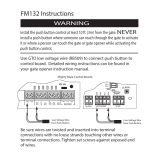 Mighty Mule FM132 Operating instructions
Mighty Mule FM132 Operating instructions
-
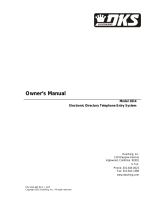 DKS Enterprises 1814 User manual
DKS Enterprises 1814 User manual
-
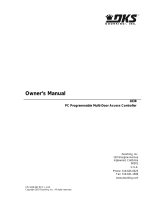 DKS Enterprises 1838 User manual
DKS Enterprises 1838 User manual
-
Linear AE-100 Installation guide
-
Nortek Contol AE-100 User manual
-
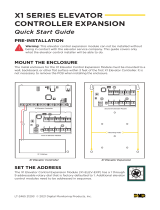 Digital Monitoring Products X1 Series Elevator Controller Expansion Quick start guide
Digital Monitoring Products X1 Series Elevator Controller Expansion Quick start guide
-
Nortek Contol AE-100 User manual
-
Select Entry Systems TEC1ACL User guide
-
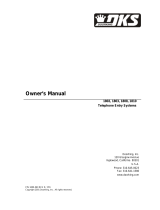 DKS Enterprises 1803 User manual
DKS Enterprises 1803 User manual
-
Nortek Contol AE-100 Owner's manual











































































